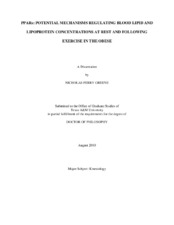| dc.description.abstract | Obesity is associated with greater rates of cardiovascular disease, dyslipidemia and dysfunctional lipid metabolism. Exercise may provide an effective therapeutic tool to ameliorate dyslipidemia. However, how exercise attenuates dyslipidemia with obesity is not fully understood. Additionally, whether acute exercise or exercise training is the primary driver of such changes in this population is unknown. Furthermore, mechanisms mediating these exercise responses are not elucidated. The peroxisome proliferator-activated receptors (PPARs) provide a likely mechanism through enhanced expression of oxidative metabolism and cholesterol transport proteins augmenting fatty acid oxidation and cholesterol transport.
Study one describes blood lipid and lipoprotein responses to acute aerobic exercise and exercise training in obese men and women. The primary measured effects include: increased HDL-C in men following 12 wks exercise training, and a shift from HDL3-C to HDL2-C, with concomitantly reduced HDL-C mean density and LDL3-C in women. Acute exercise of 400 kcal duration performed before and after training, yielded a decreased TC: HDL-C ratio in men, which was unaffected by training. Thus, the primary exercise-based treatment for dyslipidemia with obesity appears to be exercise training.
In study two, PPARδ and PGC-1α content were significantly enhanced after acute exercise, whereas PPARα and AMPKα content were augmented only after training. These effects were seen with concomitantly increased content of target proteins involved in oxidative and lipoprotein metabolism including lipoprotein lipase, CPT-I, COX-IV, and FAT/CD36. PPARδ expression was correlated with total and LDL-cholesterol concentrations. AMPKα expression was correlated with the concentration of HDL-C and its subfractions, suggesting regulation of blood cholesterols by PPARδ and AMPKα.
Study three demonstrates comparative responses to high volume resistance exercise (RE) in lean and obese Zucker rats. RE enhanced PPARδ expression regardless of phenotype, but PGC-1α in obese only. Mitochondrial biogenesis was enhanced in lean animals only, indicating PPARδ and PGC-1α content is disconnected from mitochondrial biogenesis with obesity.
These studies enhance our understanding of exercise as a therapeutic tool in treating dyslipidemia and dysregulated lipid metabolism often associated with obesity. They further demonstrate the necessity for exercise training to attenuate dyslipidemia, while illustrating PPAR-mediated augmentations in oxidative and lipoprotein metabolism following exercise with obesity. | en |


